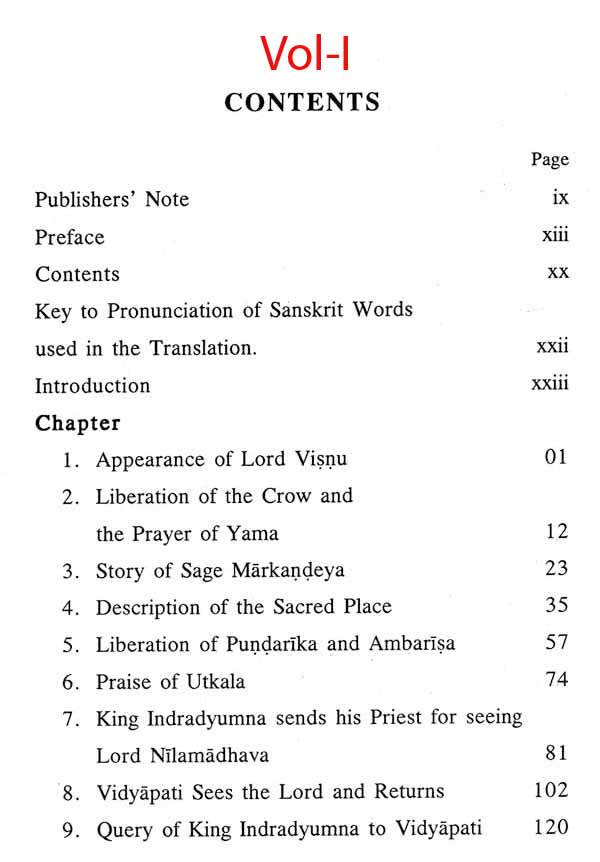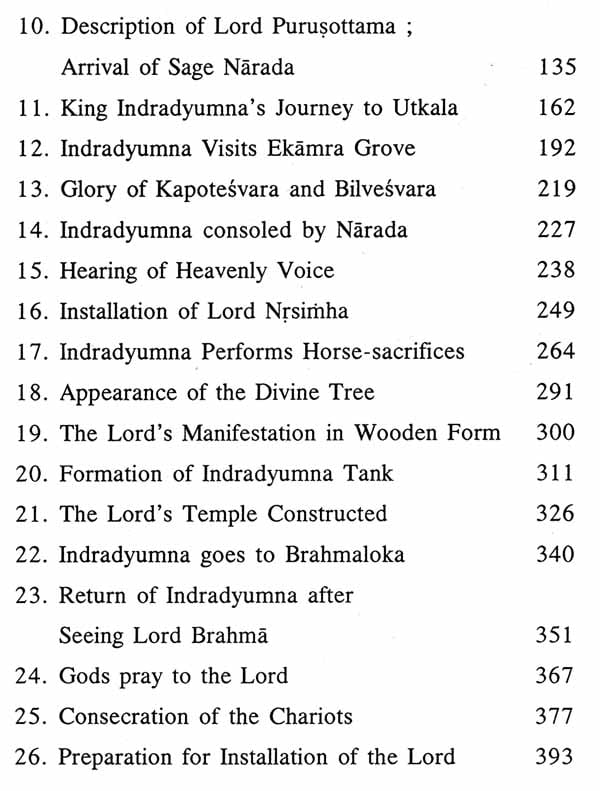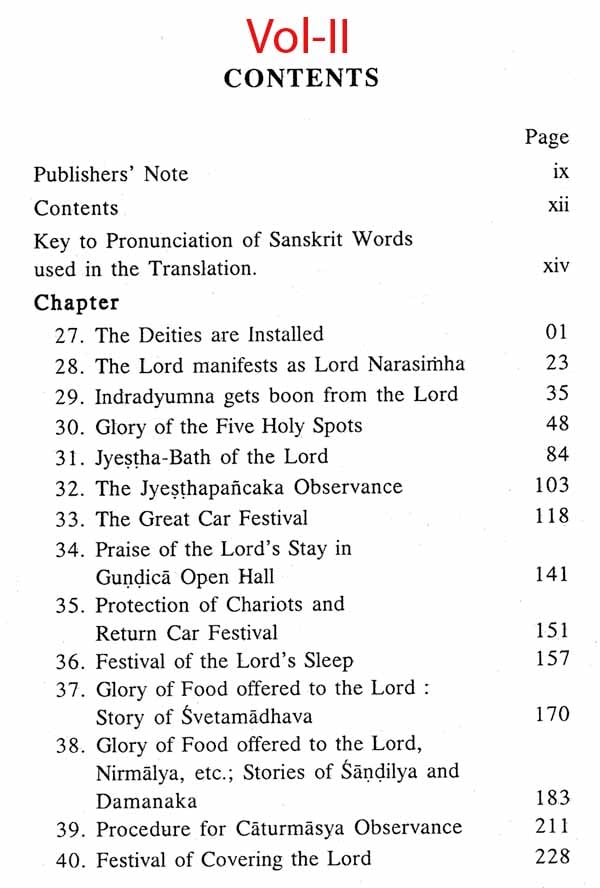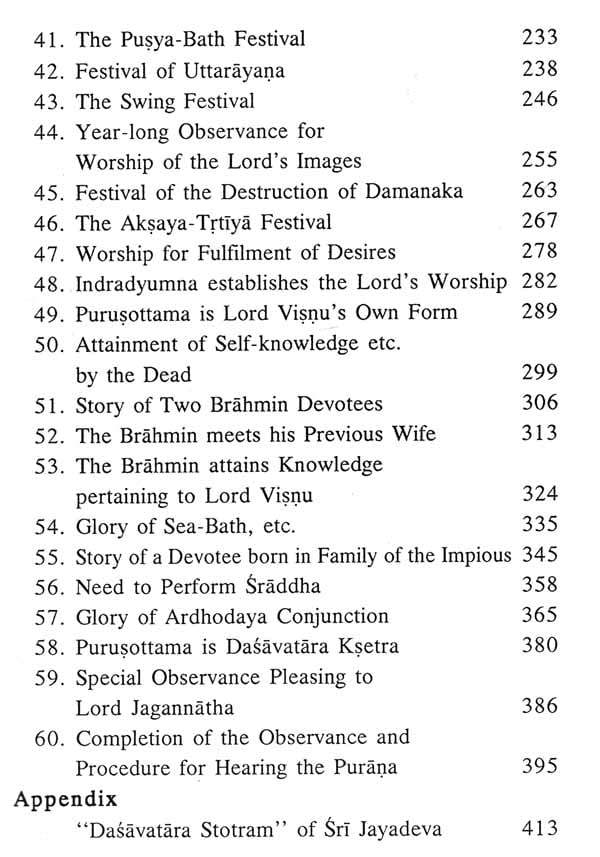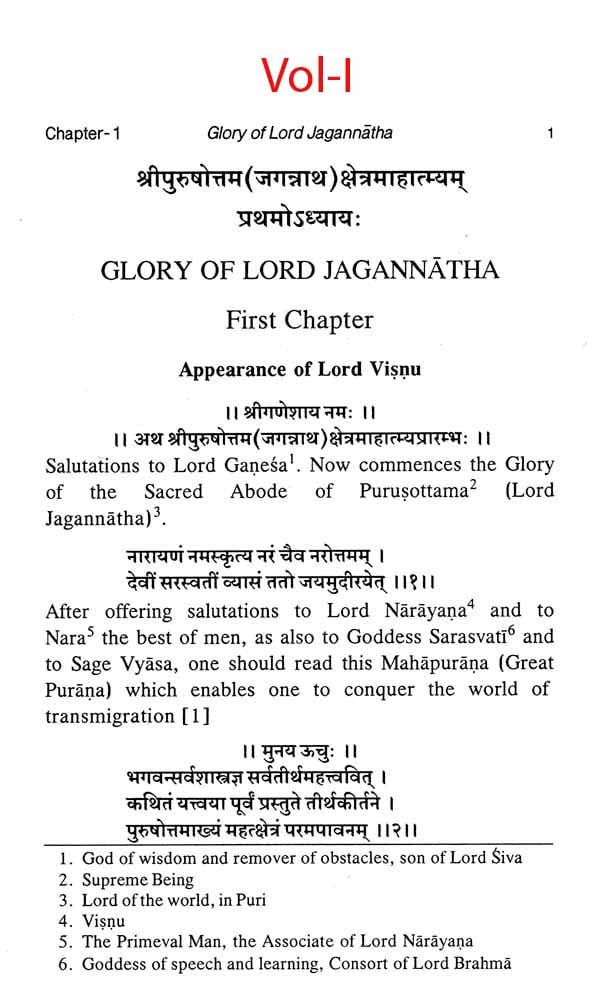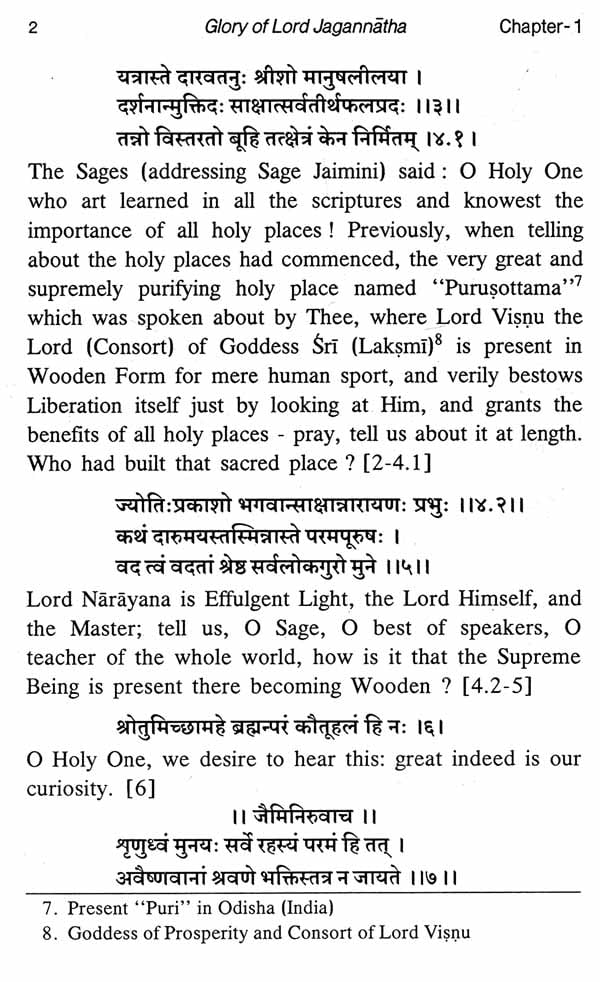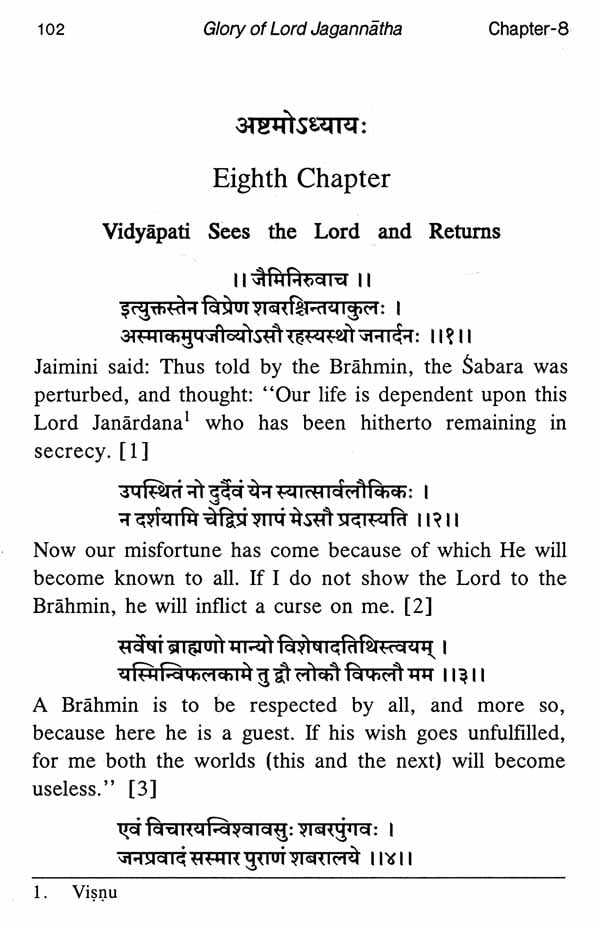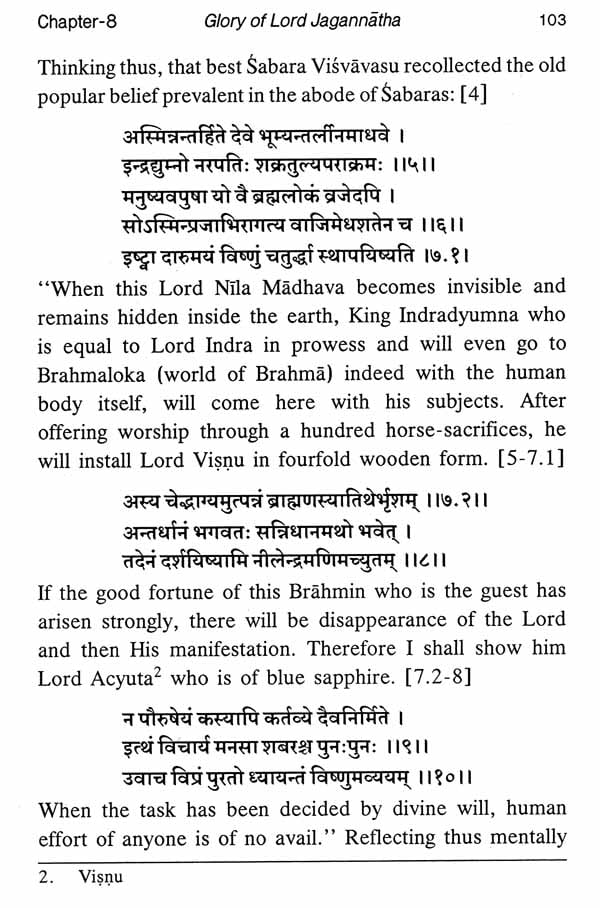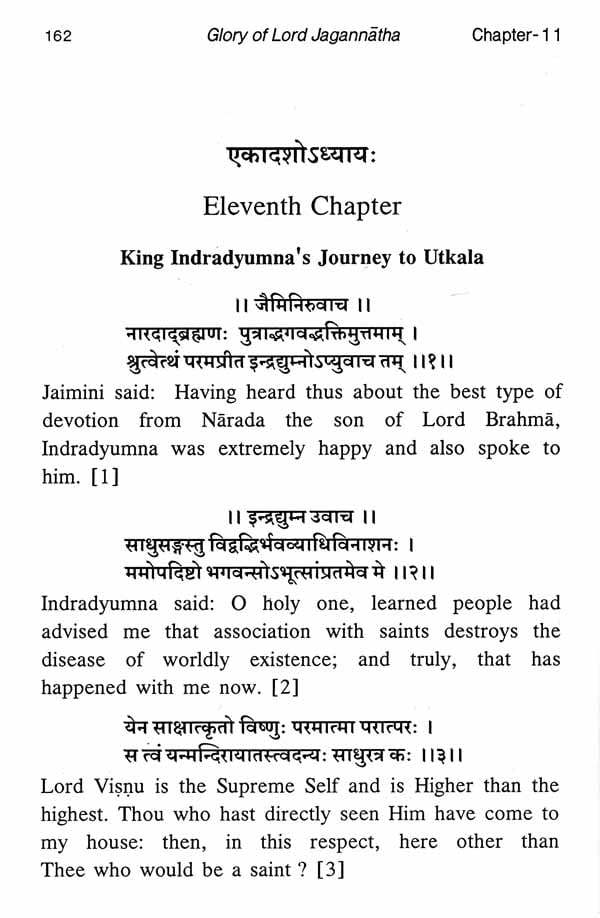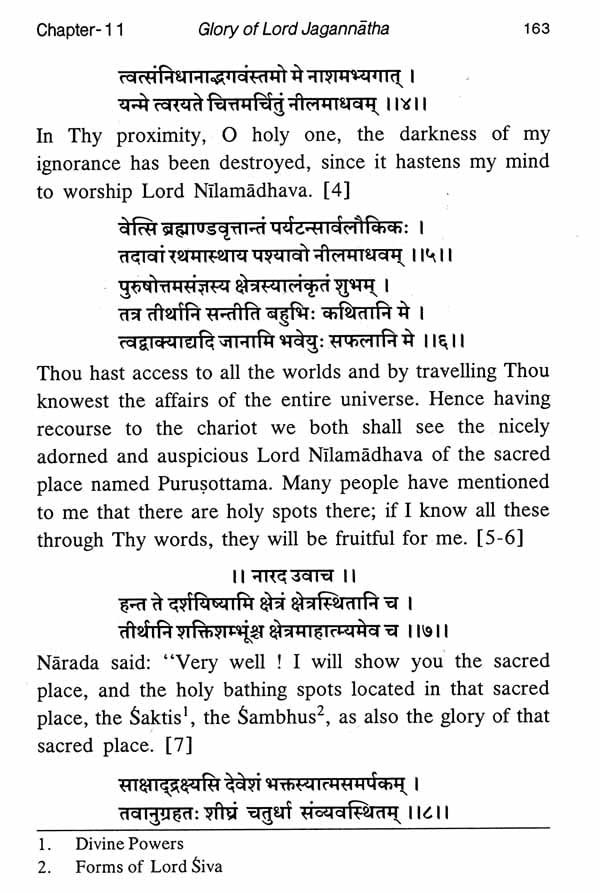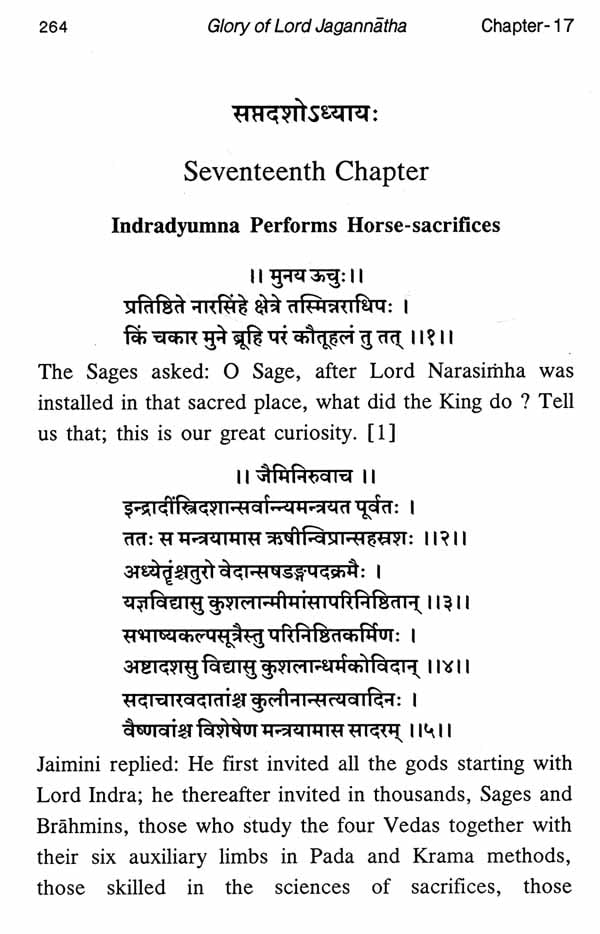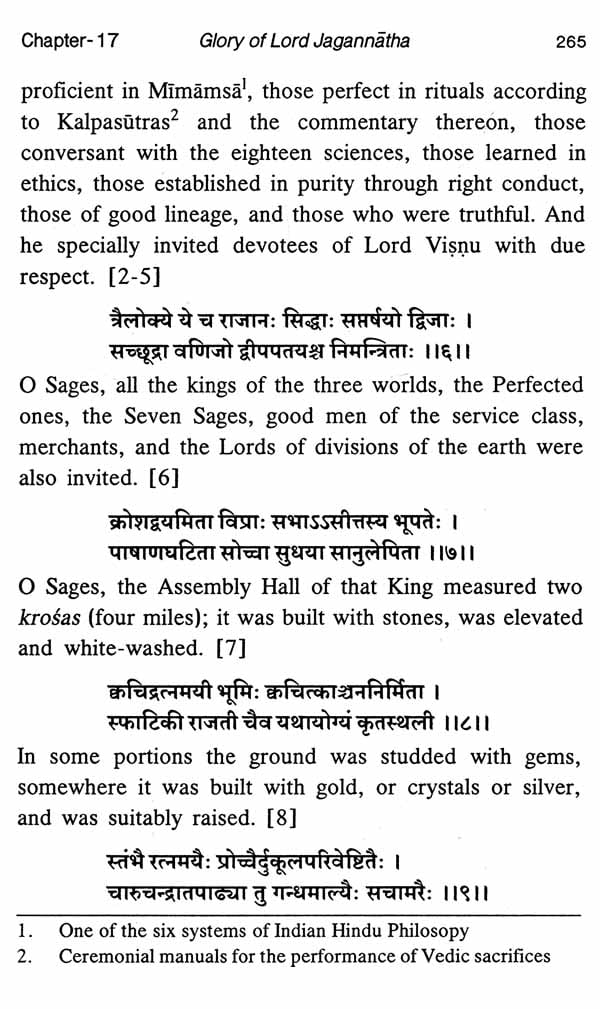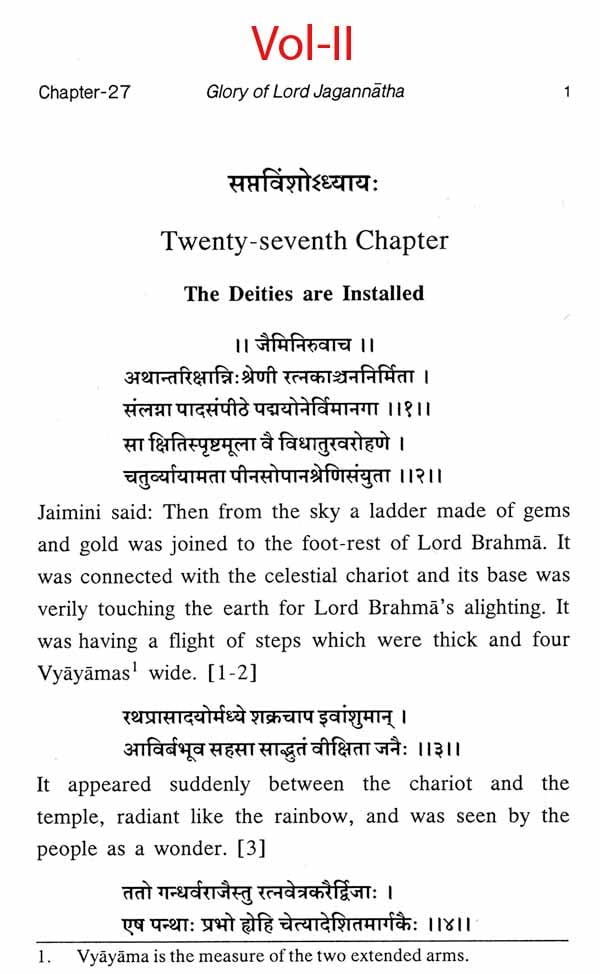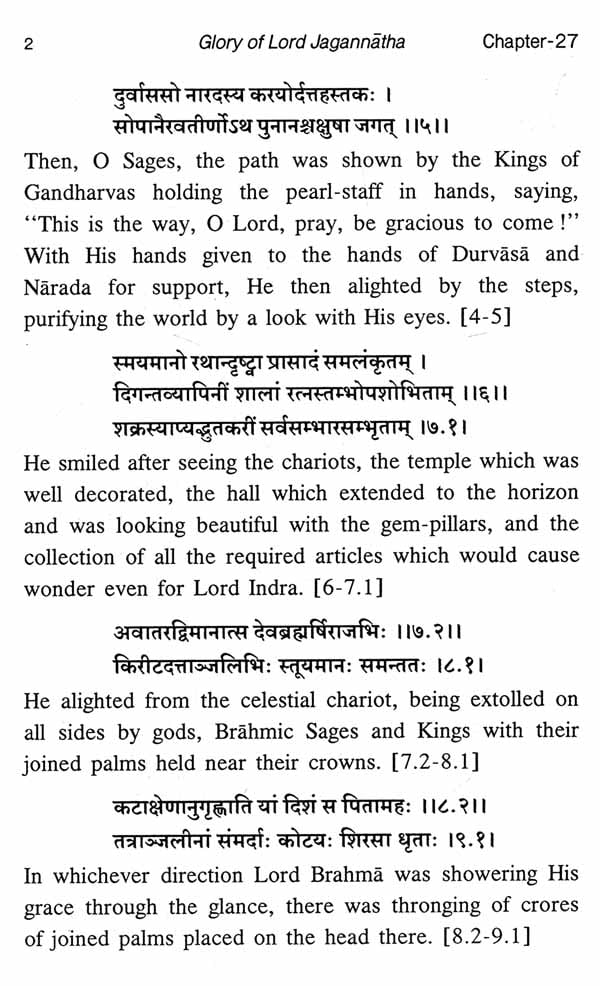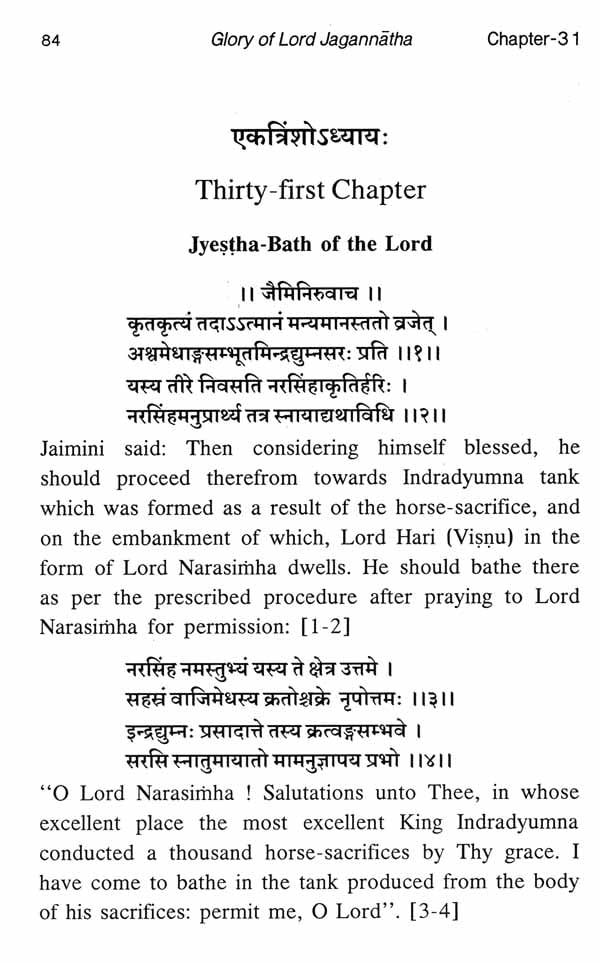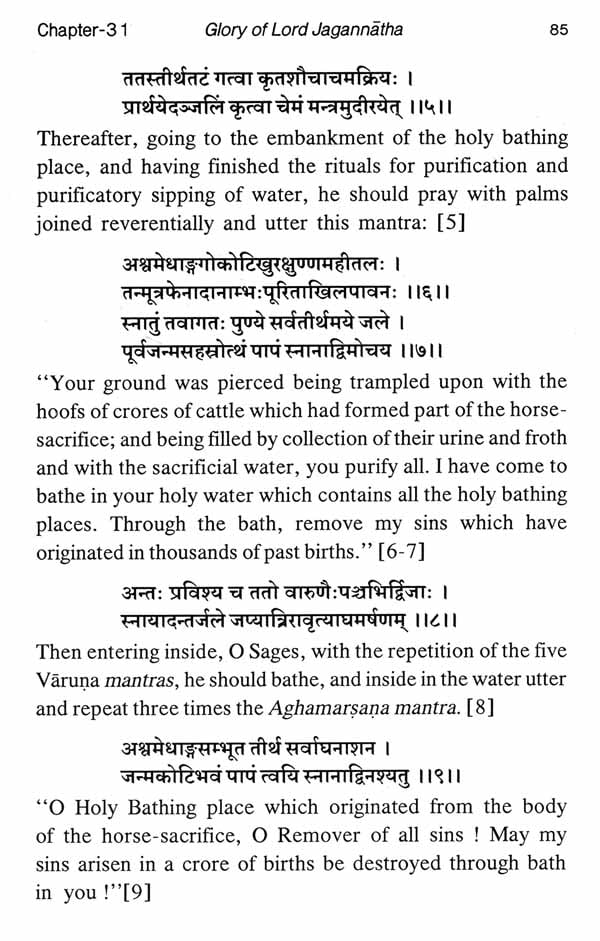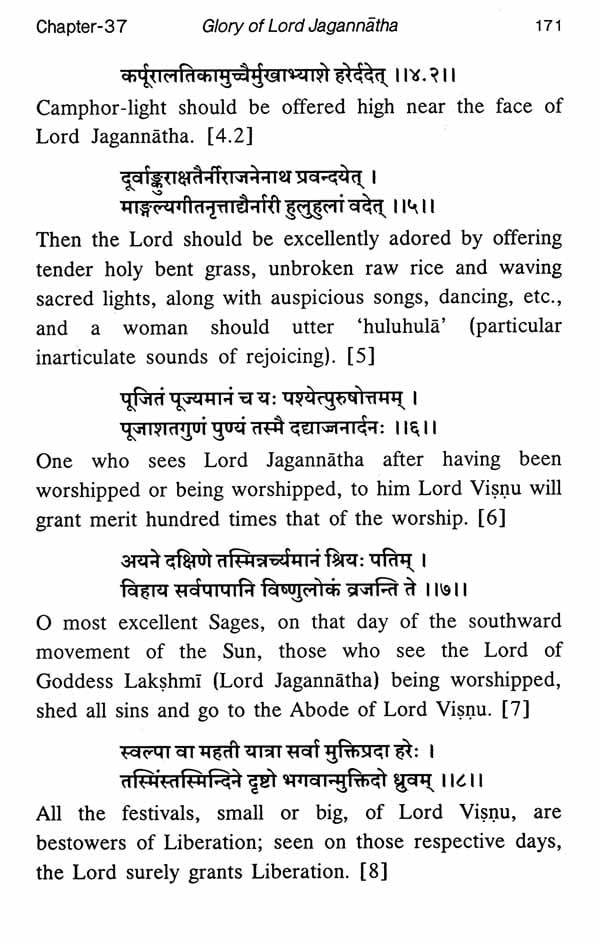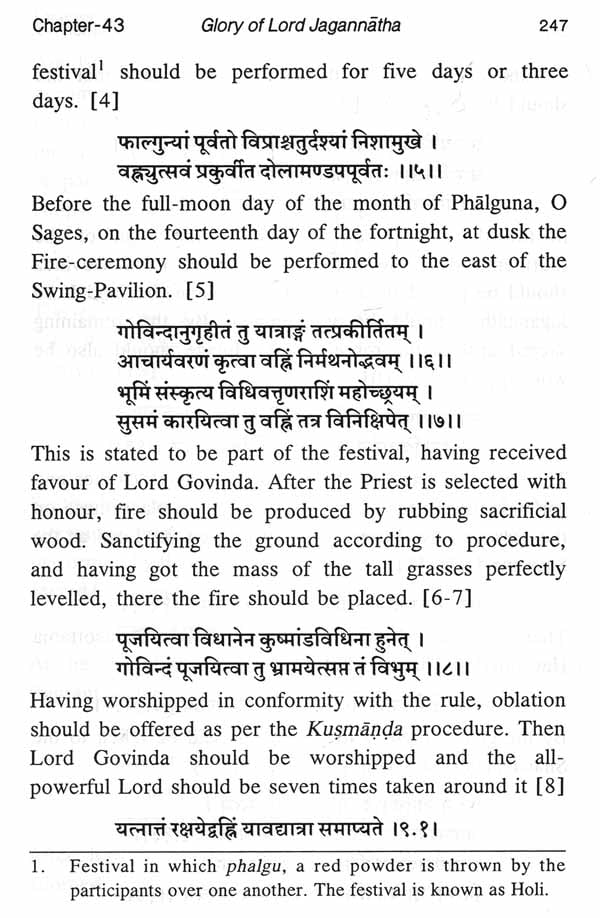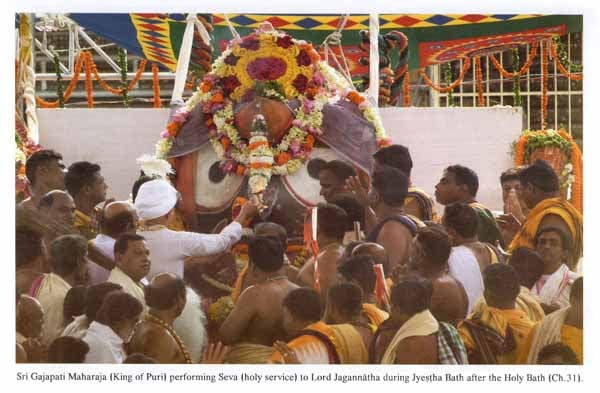
श्री पुरुषोत्तम (जगन्नाथ) क्षेत्रमाहात्म्यम्- Glory of Lord Jagannatha (Set of 2 Volumes)
Book Specification
| Item Code: | NAZ135 |
| Author: | Swami Nirliptananda |
| Publisher: | THE DIVINE LIFE SOCIETY |
| Language: | Sanskrit Text with English Translation |
| Edition: | 2019 |
| ISBN: | Vol-I: 8170522560 Vol-II: 8170522579 |
| Pages: | 876 (25 Color Illustrations) |
| Cover: | HARDCOVER |
| Other Details | 9.00 X 6.00 inch |
| Weight | 1.27 kg |
Book Description
Lord Jagannatha of Puri who is the manifestation of Lord Vishnu, the Supreme Being, is the Presiding Deity of the people of Orissa, in India. Puri has been one of the four Dhamas or Abodes of the Divine in India on account of the Divine Presence of Lord Jagannatha. The Deity is in wooden form and is known as Darubrahma, or the Supreme Reality manifested in wooden form. Sri Purushottama (Jagannatha) Kshetra Mahatmya contained in Skanda Mahapurana of Sage Vyasa gives a detailed account of the manifestation of the Lord and the circumstances leading to it. The present Book is an English translation of the original work which is in Sanskrit. It delineates the glories of Lord Jagannatha, and depicts in detail the festivals connected with the Lord, and the various other aspects, highlighting their importance and value. The primary purpose of the Lord's manifestation and Presence there is to grant to mankind Supreme Liberation by destroying sins, removing all sorrow, conferring incessant bliss and bestowing freedom from worldly existence with all its attendant misery. A study of the Book new be of immense benefit as it makes one's life holy and sublime, draws the Lord's blessings and paves the way for Supreme Blessedness.
Swami Nirliptananda Saraswati is a monk of Sivananda Ashram, Rishikesh (Himalayas), India, hailing from Orissa State. Before he became a monk, his name was Sunil Kumar Patnaik. He came to know of Sri Swami Sivanandaji Maharaj, and Sivananda Ashram and The Divine Life Society founded by him at Rishikesh, in 1965. Ever since, he has been associated with the activities and work of The Divine Life Society in various spheres at its Headquarters as also its Branches, and in Orissa State. In 1989, he gave up the activities in the secular world and joined Sivananda Ashram. He was ordained into the holy order of Sannyasa in the year 1990, and he is now staying at The Divine Life Society Headquarters at Sivananda Ashram, Rishikesh. At present, he is a Vice-President of The Divine Life Society. Having spent substantial part of his life in Orissa, he has had the great blessing of the All-merciful Lord Jagannatha to visit Puri several times and have holy Darshan (glimpse) of the Lord.
`GLORY OF LORD JAGANNATHA' is an English translation of `Purusottama (Jagannatha) Ksetra Mahatmyam' of the Vaisnava Khanda of Skanda Mahapurana of Sage Vyasa, which is in Sanskrit. This deals with the Glory of the Supreme Being manifest as Lord Jagannatha and present fourfold as Lord Jagannatha, Balabhadra, Subhadra and Sudarsana in Purl of Orissa State, India, and who is the Presiding Deity of the people of that State. Because of the Divine Presence of Lord Jagannatha, Puri is one of the four Dhamas (Chief Abodes of the Divine or most important holy places) of India, and the others are Badrinath, Dwaraka and Rameswar.
Revered Baba Chaitanya Charan Dasji Maharaj of Bhagavata Ashram, Puri, with whom I have very close personal contact for several years, had translated this Book from Sanskrit into Oriya, the language of the people of Orissa. After his translation was published, both himself and Revered Gajapati Maharaja Sri Dibyasingha Debji of Puri had met and made a request to His Holiness Sri Swami Chidanandaji Maharaj, the then International President of the Divine Life Society, Rishikesh, that Babaji Maharaj's Oriya version may also be rendered into English. Pujya Babaji had expressed the wish that Prof. Dr. S. C. Behera and myself might help in the preparation of the English translation.
Paramapujya Swamiji Maharaj accepted this suggestion and wrote to me: "In the event of Dr. Behera being too preoccupied, Revered Babaji feels your goodself will be able to help for this English translation, and you may kindly render all needful assistance in this matter." That is how, because of non-availability of Prof. Behera, ultimately it so happened that I was to take up the English translation work, though up to that time I had no idea or thought of doing any such work. It is all solely the Lord's Will !
Pujya Sri Babaji Maharaj and Revered Gajapati Maharaja had also made the request to Most Revered Swamiji Maharaj that the publication of the English translation may be undertaken by The Divine Life Society and Swamiji Maharaj had promised to give due consideration to their request. Because of this The Divine Life Society Headquarters has very kindly agreed to take up the Publication as also printing of the English Translation which has been a very kind gesture and valuable help and support.
Due to some unavoidable difficulties it was not possible to do the English rendering of Babaji Maharaj's Oriya version and it was felt appropriate to do a direct English translation from the original Sanskrit text. Thus the present work is an English Translation made directly from the original scripture in Sanskrit, and not an English rendering of any other translation. For various reasons beyond control, the work could not be published earlier and now it is ready for publication and making available for the public.
For the purpose of the Translation, the Sanskrit text which contains sixty chapters has been finalised mostly on the basis of the available publication of Skanda Purana by Chowkhamba Sanskrit Series Office, Varanasi, and also taking the help of publications of Sri Venkateshwara Press of Mumbai, and "Purusottama Mahatmya" of Baba Chaitanya Charan Dasji, as considered necessary, avoiding the errors in printing, etc. as per necessity. This is a verse-to-verse translation, and for better appreciation and facility of easy reference to the Sanskrit text, the English rendering has been given after each sloka or group of slokas, and the sloka number has also been indicated. Since some Sanskrit names and words had to be used in the Translation, for help in their pronunciation, standard diacritical marks have been used where necessary, as shown in the "Key to Pronunciation of Sanskrit words."
It is the infinite Grace of Lord Jagannatha that has associated me in the work of translation as an instrument, giving me an opportunity to give a little humble service to the Lord. At every stage, it is the Lord's blessings that carried me through and also enabled me to complete the work. It is the Will of the Lord that the Translation is published now and in the present form and shape. My humble prostrations and salutations to the All-compassionate Lord.
His Holiness Sri Swami Chidanandaji Maharaj, the International President of The Divine Life Society (Sivanandashram), Rishikesh, had very kindly approved my being connected with the translation work, blessed me and had also given me so kindly very valuable guidance with regard to the work. It is because of his kind favourable disposition that the Translation is published by The Divine Life Society. I express my humble salutations and reverential gratitude to Most Revered Swamiji Maharaj for all this.
I am immensely thankful to The Divine Life Society for having so kindly decided to agree to take up the publication and printing of this English Translation, and to the Yoga Vedanta Forest Academy Press of the Society for the printing work.
My special grateful thanks are for H.H. Sri Swami Vimalanandaji Maharaj, President of The Divine Life Society, and for H.H. Sri Swami Padmanabhanandaji Maharaj, General Secretary, for this kind gesture and decision, and generous help.
Skanda Mahapurana of which "Purusottama (Jagannatha) Ksetra Mahatmya" is a part is a major purana. Puranas are a class of classical Sacred Sanskrit literature containing narratives of ancient times dealing mostly with mythology and ancient tradition and are thus to some extent also quasi-historical. Sage Vyasa is considered to be an incarnation of Lord Visnu. After systematising and dividing the Veda into four as Rk, Yajus, Sama and Atharva, he compiled the Purana, containing the essential teachings of the Vedas and including therein tales, stories, anecdotes, songs and traditional lore as had come down over the centuries, for the benefit and easy understanding of the common man who would find it difficult to delve deep into the Vedic texts as such. It is termed as "Purana" as it is ancient, and clarifies the Vedas.
The Brhadaranyaka Upanisad, as also the Satapatha Brahmana (14/2/4/10), says that like the Vedas, Upanisads, etc., the puranas along with some other texts have all come out of the breath of the Great Supreme Being, thereby indicating their sacredness and authenticity. Acharya Sankara holds that the epics and puranas which have the mantra and arthavada (statement of facts or eulogistic Vedic passages recommending certain action) as their foundation are trustworthy evidence and as such are authoritative like other such texts. Further, it is also enjoined that a learned man cannot be well-versed, in spite of having knowledge of the four Vedas together with their ancillaries and the upanisads, if he has not thoroughly studied the puranas, and hence the knowledge of the Vedas is required to be augmented or supplemented by the Epics and Puranas. All this goes to show that the Purana is authentic, authoritative, and an essential source of knowledge, as much as it is sacred.
The original single Purana was divided by Vyasa in course of time into eighteen Mahapuranas or major Puranas. Of these Skanda is the largest, comprising 81,000 slokas (verses). Thus Vyasa is the author of the Skanda Mahapurana. Its name is derived from Lord Skanda (Kartikeya), the second son of Lord Siva, who is stated to have first created the Purana and revealed to the world. It gives a detailed account of the glories and importance of the important holy places and pilgrim centres of India, also providing a description of the different regions, geography, culture, etc. It has seven Khandas or Major Divisions (books) which are : Maheswara, Vaisnava, Brahma, Kasi, Avanti, Nagara, and Prabhasa. Each Khanda is basically devoted to one major deity or important area and most of the Tirthas or holy places pertaining to it. Thus, the second Khanda or the Vaisnava Khanda deals with the holy places and subjects sacred to Lord Visnu and their importance, and has as its second Section Purusottama (Jagannatha) Ksetra Mahatmya or the Glory of the Sacred Abode of Lord Jagannatha who is a manifestation of Lord Visnu. Lord Jagannatha (which means Lord or Master of the World) is Purusottama or the Supreme Being.
Besides Skanda Mahapurana, Lord Jagannatha has also been mentioned in many other scriptures. There is reference even in the Vedas to the Deity in Wooden Form (Purusottama or Jagannatha) on the Sea-coast as the means to reach the Supreme Abode. The Rg Veda has this mantra (10th Mandala, Sukta 155, Mantra 3) :
**Contents and Sample Pages**
